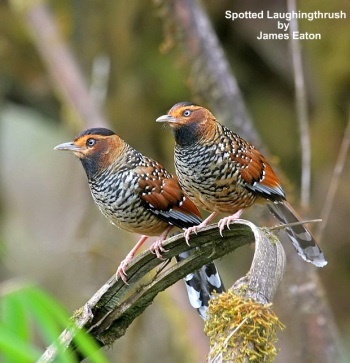Alternative names: Ocellated Laughingthrush; White Laughingthrush; White-spotted Laughingthrush
- Pterorhinus ocellatus
Garrulax ocellatus
Identification
30 - 33cm (11¾-13 in). A very large laughingthrush.
- Rufous-olive to chestnut upperparts with numerous black-and-white spots
- Black crown, lower throat and upper breast
- Rufous-buff underparts with black-and-white spots and bars on breast
- Warm buffish to rufous face, supercilium and chin
- Black and grey flight-feather trim
- Grey-trimmed, long chestnut tail
Similar Species
Similar only to Giant Laughingthrush.
Distribution
Found in the Himalayas from north India over Nepal and Bhutan to northeast India. Also in mountains of northern Burma and south-central China.
Fairly common in most of its range.
Taxonomy
Has been treated conspecific with Giant Laughingthrush.
Also placed in the genus Ianthocincla.
Subspecies
Four subspecies recognized[1]:
- G. o. griseicauda in north India (Uttaranchal Pradesh) and western Nepal
- G. o. ocellatus from central Nepal east to Bhutan, Arunachal Pradesh (northeast India) and adjacent Tibet.
- G. o. maculipectus in northern Burma and southern China (Yunnan)
- G. o. artemisiae in east-central China (Gansu, Sichuan, Yunnan, Hubei)
Habitat
Undergrowth in high-elevation forest, thick rhododendron scrub and bushes. Usually at 2135m - 3660m, sometimes higher.
Behaviour
Diet
Feeds on insects, fruit and seeds.
Forages on the ground or in bushes, usually in pairs or small groups of 3 - 8 birds. Inconspicuous. Often associated with Black-faced Laughingthrush.
Breeding
Breeding season from May to June in China. The nest is a large, loose cup made of twigs, dry grasses, bamboo leaves, roots, moss and ferns. It's placed in a bush or a small tree, close to the ground. Lays 2 eggs.
Resident species with some winter dispersal.
Vocalisation
Great Parrotbill with Spotted Laughingthrush
Recording by china guy, Sichuan, China, August 2011
Background calls include Claudia's Leaf Warbler, Elliot's Laughingthrush, White-browed Fulvetta and various tits
Recording by china guy, Old Erlang Road, Sichuan, China, August 2011
References
- Clements, J. F., T. S. Schulenberg, M. J. Iliff, S. M. Billerman, T. A. Fredericks, B. L. Sullivan, and C. L. Wood. 2019. The eBird/Clements Checklist of Birds of the World: v2019. Downloaded from http://www.birds.cornell.edu/clementschecklist/download/
- Del Hoyo, J, A Elliott, and D Christie, eds. 2007. Handbook of the Birds of the World. Volume 12: Picathartes to Tits and Chickadees. Barcelona: Lynx Edicions. ISBN 978-8496553422
- Rasmussen, PC and JC Anderton. 2005. Birds of South Asia: The Ripley Guide. Barcelona: Lynx Edicions. ISBN 978-8487334672
Recommended Citation
- BirdForum Opus contributors. (2024) Spotted Laughingthrush. In: BirdForum, the forum for wild birds and birding. Retrieved 27 April 2024 from https://www.birdforum.net/opus/Spotted_Laughingthrush





